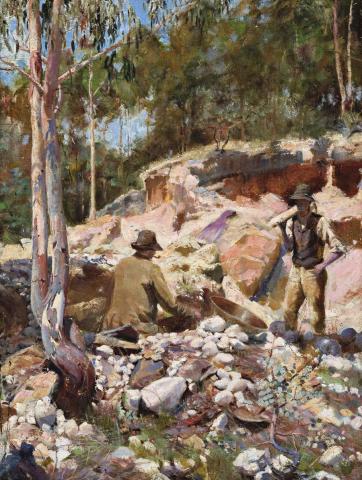FOSSICKING FOR GOLD, 1893
JAMES MILLER MARSHALL
oil on canvas laid down on board
44.0 x 33.0 cm
Private collection, Melbourne
Thence by descent, private collection, Victoria
Fossicking for Gold, 1893, oil on canvas, 55.0 x 39.0 cm, Christie's, Melbourne, 3 May 1988, lot 116 (erroneously catalogued as James Miller Marshall)
There is a freshness about John Miller Marshall's Fossicking for Gold that speaks of painting directly from the subject in the open air. Painted in the style and technique favoured by and made a favourite by the Australian Impressionist artists, it probably depicts a mining scene at Creswick, close to the fabled goldfields of Ballarat in Victoria. A comparison between this painting and the related work of the same title suggests that our work is a well realised and spontaneous study for the slightly larger one. The latter is more 'finished' in execution with minor changes in detail and composition that suggest careful consideration, whereas the former has a greater freedom of conception that characterises instinctive and immediate response. The adjusted positions of the pan used in washing for alluvial gold and the shovel are such examples, as well as the adjusted angle of the head in the miner with the pick across his shoulder.
Marshall, a British artist who visited Australia in the early 1890s, is an historically elusive character who touched briefly the lives of significant Australian artists Walter Withers and two members of the famed Lindsay family. During January 1893, Withers and Marshall conducted a summer school at Creswick, the students, including Percy and Lionel Lindsay, painting out-of-doors. Withers also busily painted several gold mining subjects with a Creswick setting, a fine example being Mining Scene, Creswick, 1893, in the collection of the Ballarat Fine Art Gallery. Also in the same gallery are several gold field subjects by Percy Lindsay including Miner Panning, Creswick, c.1893.
The painting on offer shows that Marshall was no exception, his Fossicking for Gold being very much in the Australian Impressionist tradition with its sparkling colours and atmosphere, of blue shadows and a central touch of purple. The influence of Withers and Frederick McCubbin is apparent in Marshall's technique and colour scheme, the young blue gum tips in the fight foreground being almost as close to McCubbin as his signature. The presence of McCubbin and Withers is also felt in the handling of the trunks of the saplings to the left. Nevertheless, the whole painting expresses the artistic individuality of Marshall, of ideas and influences learnt and translated into his own artistic language.
DAVID THOMAS
